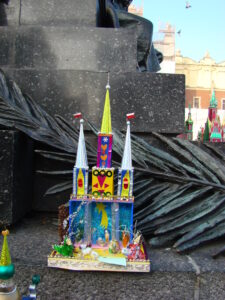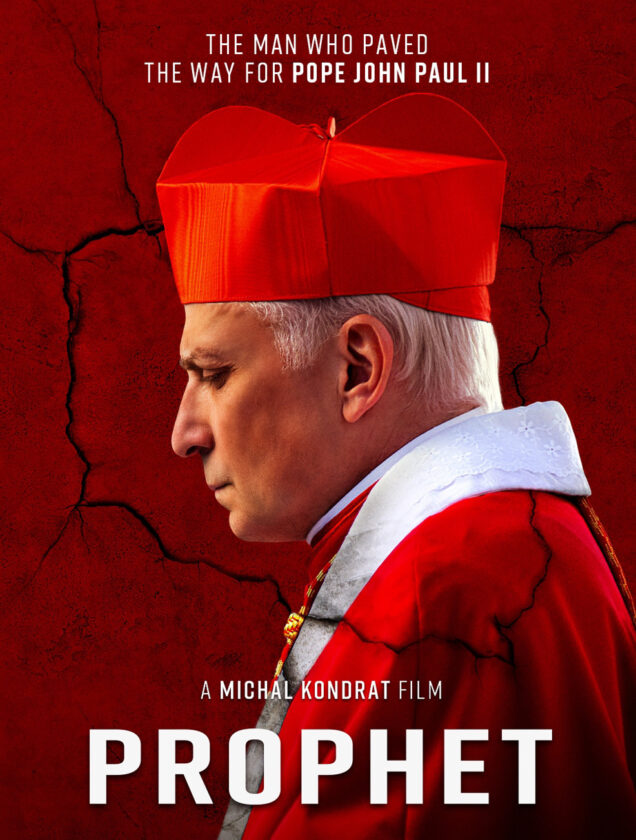This year PACT will have a shopka in the Toledo Holiday Parade.
(From PolAmJournal.com)
by Stas Kmiec
Mention the word szopka (creche) or jaselka (nativity play) to someone born in Poland long ago, and you will see a spark of joy light up in their eyes. They recall the live nativity scenes, puppet shows, pageant plays and shimmering fairy tale castle-like scenes of their youth.
The Christmas creche is common to all of the Christian faith, but the szopka is unique to Poland. The szopka, once a humble peasant pleasure, has become a recognized Polish institution. A truly Polish Christmas celebration is not complete without some form of this scene.
The custom originated with St. Francis of Assisi, who set the first Nativity tableau in 1223. It was brought to Poland by Franciscan monks around the 13th century. The earliest sign of a manager scene in Poland was in St. Andrew’s church in Kraków. The first crìches were quite simple and portable, but eventually monks took on the roles of the figurines, with the exception of the infant and animals, and developed a living nativity.
Dialogue crept in and eventually the jaselka play developed. The monks were replaced by peasants, students, artisans and even the nobility. Figures from history, local tradition and legend, such as Pan Twardowski were added for national color. Allegorical figures such as the devil and smierc (death) carrying a scythe soon appeared, along with Biblical figures, such as, the Holy Family and King Herod.
The still managers became filled with multi-figure compositions. In addition to the Biblical figures and animals, Polish peasants in their regional finery and whole armies accompanying the three kings were displayed.
By the eighteenth century these figures were moveable. Stringed marionettes or stick puppets replaced the static figures. The performances presented two types of integrated plots: a Biblical one telling the Nativity story and a lay one of traditional, folk and satirical nature.
Still taking place in church, it was soon realized that the excitement of such an entertainment had gotten out of hand. In 1736 these plays were banned from the churches by Bishop Teodor Czartoryski, permitting only immobile scenes of a strictly Biblical Christmas. Both the live and puppet shows now were passed down to the people, who included them in the ritual of caroling (kolednicy). Following the ban the performances evolved into a true expression of folk art.
The live Jaselka became a traveling show beginning on St. Stephen’s day (December 26). The Bethlehem locale, was now set in Poland. Original characters and much of the traditional dialogue were preserved, but in the hands of artists and students it became a mirror of community life, with political satire and local anecdotes added in. Key moments were preserved, such as the well- known scene between King Herod and the devil. The devil triumphantly exclaims in retribution for Herod’s Massacre of the Innocents, “Królu Herodzie za twe zbytki, chodz do piekla, bos ty brzydki” (King Herod for your wicked ways come with me to hell because you are deplorable). This scene was extremely popular with the audience.
In literature and theater, the plays were made famous by such authors as Lucjan Rydel (Betlejem Polskie) and Leon Schiller (Szopka Krakowska and Pastoralka), and continue to appear in the repertoire of professional theater companies in Poland to this day.
Throughout the 18th century, native artisans were making crìches that were distinctively Polish in architectural design, folk costume and motif. Each region developed its own unique design, but it was in Kraków that it developed into a high art.
By the 19th century several elements defined the szopka’s shape, finding inspiration in the existing structures of Kraków. The stable’s roof was covered by a second story and was flanked by two towers. The two towers eventually resembled the Kosciól Mariacki (St. Mary’s Church) and the central Renaissance dome was reminiscent of Wawel Castle’s Zygmunt Chapel. By the end of the 19th century the stable was moved to the second floor and bottom floor was filled with figuures of folklore and history.
The outbreak of World War I brought an end to the szopka, when Austrian occupation forces prohibited home-to-home caroling accompanied by a szopka. Due to the change in political climate after Poland had regained its independence in 1918, it seemed this form of folk art would disappear entirely. A Jaselka was staged at a Kraków theater in 1923 and this sparked a revival of sorts. Szopki were made and sold as souvenirs. The city’s municipal authorities decided to save this decaying tradition by announcing the first competition in December of 1937. Eighty-six cribs were entered. With the exception of the wartime period of 1939-1944 the competitions have become an annual holiday tradition with a magnitude of entrants. Kraków hosts the competition in the central Rynek (marketplace) Square. The puppet shows survive to this day as popular entertainment and are included in this event, as well.



